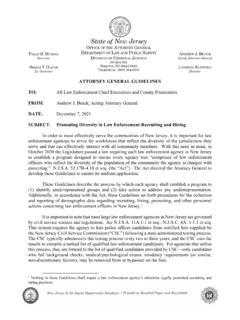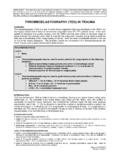Transcription of U.S. Voting Rights Timeline
1 Voting Rights Timeline -1- Northern California Citizenship Project Mobilize the Immigrant Vote 2004 - Capacity Building Series 1776 Only people who own land can vote Declaration of Independence signed. Right to vote during the Colonial and Revolutionary periods is restricted to property owners most of whom are white male Protestants over the age of 21. 1787 No federal Voting standard states decide who can vote Constitution adopted. Because there is no agreement on a national standard for Voting Rights , states are given the power to regulate their own Voting laws. In most cases, Voting remains in the hands of white male landowners. 1789 George Washington elected president.
2 Only 6% of the population can vote. 1790 Citizen=White 1790 Naturalization Law passed. It explicitly states that only free white immigrants can become naturalized citizens. 1848 Activists for ending slavery and women s Rights join together Women s Rights convention held in Seneca Falls, NY. Frederick Douglass, a newspaper editor and former slave, attends the event and gives a speech supporting universal Voting Rights . His speech helps convince the convention to adopt a resolution calling for Voting Rights for women. 1848 Citizenship granted, but Voting denied The Treaty of Guadalupe-Hidalgo ends the Mexican-American War and guarantees citizenship to Mexicans living in the territories conquered by the However, English language requirements and violent intimidation limit access to Voting Rights .
3 1856 Vote expanded to all white men North Carolina is the last state to remove property ownership as a requirement to vote. 1866 Movements unite and divide Two women s Rights activists, Elizabeth Cady Stanton and Susan B. Anthony, form an organization for white and black women and men dedicated to the goal of universal Voting Rights . The organization later divides and regroups over disagreements in strategies to gain the vote for women and African Americans. 1868 Former slaves granted citizenship 14th Amendment to the Constitution passed. Citizenship is defined and granted to former slaves. Voters, however, are explicitly defined as male. Although the Voting Rights Timeline -2- Northern California Citizenship Project Mobilize the Immigrant Vote 2004 - Capacity Building Series amendment forbids states from denying any Rights of citizenship, Voting regulation is still left in the hands of the states.
4 1870 Vote cannot be denied because of race, explicitly so other discriminatory tactics used 15th Amendment passed. It states that the right to vote cannot be denied by the federal or state governments based on race. However, soon after, some states begin to enact measures such as Voting taxes and literacy tests that restrict the actual ability of African Americans to register to vote. Violence and other intimidation tactics are also used. 1872 Women try to vote Susan B. Anthony is arrested and brought to trial in Rochester, New York, for attempting to vote in the presidential election. At the same time, Sojourner Truth, a former slave and advocate for justice and equality, appears at a polling booth in Grand Rapids, Michigan, demanding a ballot but she is turned away.
5 1876 Indigenous people cannot vote The Supreme Court rules that Native Americans are not citizens as defined by the 14th Amendment and, thus, cannot vote. 1882 The Chinese Exclusion Act bars people of Chinese ancestry from naturalizing to become citizens. 1887 Assimilation=Right to Vote Dawes Act passed. It grants citizenship to Native Americans who give up their tribal affiliations 1890 Wyoming admitted to statehood and becomes first state to legislate Voting for women in its constitution. 1890 Indigenous people must apply for citizenship The Indian Naturalization Act grants citizenship to Native Americans whose applications are approved similar to the process of immigrant naturalization.
6 1912-13 Women lead Voting Rights marches through New York and Washington, 1919 military Service=Citizenship for Native Americans Native Americans who served in the military during World War I are granted citizenship. Voting Rights Timeline -3- Northern California Citizenship Project Mobilize the Immigrant Vote 2004 - Capacity Building Series 1920 Right to vote extended to women 19th Amendment passed, giving women right to vote in both state and federal elections. 1922 Asian White Citizen Supreme Court rules that people of Japanese heritage are ineligible to become naturalized citizens. In the next year, the Court finds that Asian Indians are also not eligible to naturalize.
7 1924 Again, citizenship granted but Voting denied The Indian Citizenship Act grants citizenship to Native Americans, but many states nonetheless make laws and policies which prohibit Native Americans from Voting . 1925 military Service=Citizenship for Filipinos Congress bars Filipinos from citizenship unless they have served three years in the Navy. 1926 State violence used to prevent people from exercising their right to vote While attempting to register to vote in Birmingham, Alabama, a group of African American women are beaten by election officials. 1947 Legal barriers to Native American Voting removed Miguel Trujillo, a Native American and former Marine, sues New Mexico for not allowing him to vote.
8 He wins and New Mexico and Arizona are required to give the vote to all Native Americans. 1952 McCarran-Walter Act grants all people of Asian ancestry the right to become citizens. 1961 23rd amendment passed. It gives citizens of Washington, the right to vote for president. But to this day, the district s residents most of whom are African American still do not have Voting representation in Congress. 1963-64 Voting Rights as civil Rights Large-scale efforts in the South to register African Americans to vote are intensified. However, state officials refuse to allow African Americans to register by using Voting taxes, literacy tests and violent intimidation.
9 Among the efforts launched is Freedom Summer, where close to a thousand civil Rights workers of all races and backgrounds converge on the South to support Voting Rights . Voting Rights Timeline -4- Northern California Citizenship Project Mobilize the Immigrant Vote 2004 - Capacity Building Series 1964 No special tax to vote 24th Amendment passed. It guarantees that the right to vote in federal elections will not be denied for failure to pay any tax. 1965 Grassroots movement forces change in law Voting Rights Act passed. It forbids states from imposing discriminatory restrictions on who can vote, and provides mechanisms for the federal government to enforce its provisions.
10 The legislation is passed largely under pressure from protests and marches earlier that year challenging Alabama officials who injured and killed people during African American voter registration efforts. 1966 After the legal change, struggle continues for social change Civil Rights activist James Meredith is wounded by a sniper during a solo Walk Against Fear voter registration march between Tennessee and Mississippi. The next day, nearly 4,000 African Americans register to vote. And other civil Rights leaders such as Martin Luther King, Jr. and Stokely Carmichael continue the march while Meredith heals. Meredith rejoins March at its conclusion in Mississippi.




